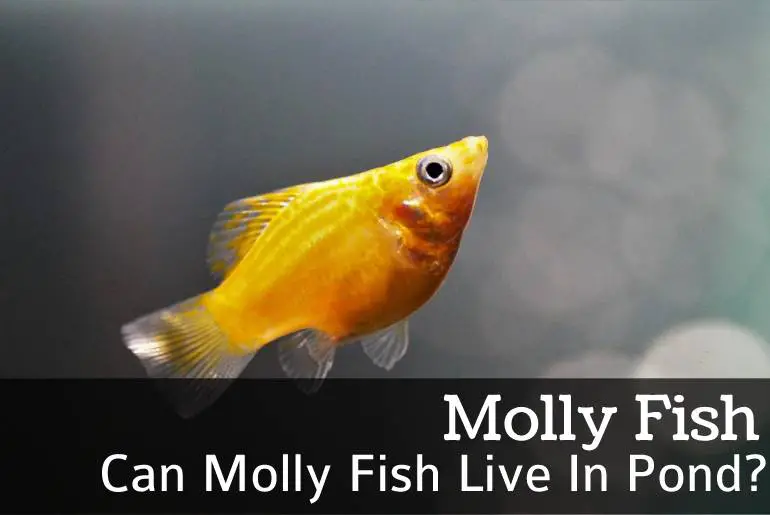Molly fish were first discovered in the early 1900s and hail from tropical climates in Central America. While quite hardy and able to tolerate a range of conditions, Molly’s health still depends on suitable water parameters. Thus, combining their attractive nature and hardiness, in this article we will be discussing how can molly fish live in an outdoor pond.
Can Molly Fish Live In an Outdoor Pond?
Yes, Molly fish can thrive in an outdoor pond when certain conditions are met. Firstly, it’s essential to replicate their native tropical environment by maintaining optimal water parameters, including a temperature range of 72-82°F. Secondly, ensuring the safety of the pond environment is crucial; protects them from potential predators and provides suitable shelter.
During summer, natural pond covers can offer shade, while in winter, a pond heater helps maintain a stable temperature. Lastly, regular monitoring, proper feeding, and attention to their well-being contribute to a successful and thriving outdoor pond for Molly fish.
5 Challenges To Know When You Keep Molly In Outdoor Pond
While ponds seem like great molly homes, they come with unique challenges we must address:
Temperature Fluctuations
The first and foremost important thing to keep in mind when keeping Mollies in outdoor ponds is temperature. It’s not only important but also challenging to maintain water temperature in a pond as the weather change can cause the temperature to fluctuate.
Mollies behave differently depending on if it’s summer or winter. We have discussed the behavioral change of Molly due to temperature change in the article, the ideal water temperature for Molly fish.
They can handle temperature changes pretty well, but big shifts in temperature also, for instance, change the amount of oxygen in the water. For mollies to be happy and healthy, they need the water to stay between 72-82°F.
Impact of Weather Condition
Where you put the pond matters when it comes to weather. Along with temperature, lots of rain, droughts, and wind can mess with your pond and the water inside. Heavy rain can really change the pond’s chemistry and make the water more acidic.
Not enough rain causes the water level to drop as the water evaporates faster than normal.
Likewise, the wind blows junk into the pond which kicks up gunk from the bottom. All these weather issues stress out the fish. You’ll have to work hard to keep your pond balanced when the weather gets bad.
You don’t want too much direct sunlight on the pond since it causes extra algae to grow. But you also don’t want the pond in a spot that gets a ton of rain all the time. The rain alters the water temperature and chemistry. A little rain here and there is ok, but not too much.
Water pH and Hardness
Mollies need the pH to stay between 7.5-8.5 and the water hardness to be 15-30 dGH. Like we talked about with rain water, it can make the pH go down. As water evaporates, the stuff dissolved in it gets more concentrated. This concentration change can alter the pH, not the evaporation itself.
Outdoor pond water mixes with the environment. Leaves, dirt, fertilizer, minerals from the ground, rain etc all affect the pH, hardness, and toxin levels. It’s hard work keeping the water chemistry steady.
Test the pH to keep it 7-8. Add buffers to stabilize it. Check for ammonia and nitrites too. Regular partial water changes will help get rid of bad fluctuations.
Water Level Instability
Ponds lose water from evaporation. Hot and dry weather makes more water evaporate, faster. Topping off the pond is crucial to stop chemistry shifts from low water levels.
On the flip side, heavy rain can overfill ponds. Having overflow drainage controls rising water levels. Keeping the water volume steady maintains stable pond conditions.
The water level has to be maintained with rainwater or aged water, not straight from a hose unless you add a dechlorinator. But pond spray from sprinklers in small amounts is ok.
Risk of Predators
Another big worry with outdoor ponds is predators attacking the mollies.
Being outside means more danger from predators like birds, raccoons, cats, and snakes. Even bugs and dragonflies might go after small mollies.
Having lots of pond plants, netting over the pond, and sinking sections of the pond liner underground can help block predators. You can also wrap a wire cage around or over the whole pond. Putting the pond in a greenhouse structure works too.
Importance Of UV Sterilizer in Molly Pond
Let me start by explaining what a UV Sterilizer is and how it works. A UV Sterilizer is a device that uses ultraviolet light to kill harmful microorganisms like bacteria, viruses, parasites, and algae spores in the water. The light damages the DNA of the organisms, making them unable to reproduce or function, effectively killing them off. There are different types of UV Sterilizers made specifically for ponds.
Cloudy water, algae blooms, and impurities are very common in outdoor ponds since we can’t control external weather factors. Too much sunlight and excess nutrients cause algae to grow rapidly, which decreases oxygen levels in the water. This can be very dangerous for your mollies. Because the pond is outside, it’s difficult to maintain proper water parameters. Using a UV Sterilizer helps avoid issues caused by outdoor conditions. The device also kills parasites before they can infect your fish.
There are all-in-one pond filters available with built-in UV sterilization like TotalPond’s Pond Filter or Aquascape’s UltraKlean Pond Filter. You can also buy the UV Sterilizer as a separate unit to pair with your current filtration, giving you more customization.
Role Of Aquatic Plants In Molly Pond
There are lots of plant options for ponds, but I recommend easy, low-maintenance varieties if you’re a beginner. Great choices include Java Fern, Anubias, Guppy Grass, Hornwort, Cabomba, Java Moss, and floating plants like Amazon Frogbit, Dwarf Water Lettuce, Mosquito Fern, etc. Aquatic plants not only enhance aesthetics but also promote water quality. Most importantly, they help recreate the natural ecosystem mollies thrive in.
Plants remove carbon dioxide and produce oxygen through photosynthesis. They also provide plant-based food since mollies are mostly herbivorous. By absorbing excess waste and nutrients, plants prevent algae blooms caused by fish debris and runoff. Floating varieties help regulate temperature and prevent evaporation by insulating the water on hot days. Emergent pond plants offer additional benefits.
Mollies And Mosquito Larvae
Standing water provides ideal breeding grounds for mosquitos. Many avoid ponds because they fear mosquito issues. But mollies and other fish like guppies make great natural mosquito control. They’ve been used for generations to reduce mosquito populations and the diseases they transmit.
As omnivores, mollies need some meat-based foods like insects and larvae. Mosquito larvae satisfy this need while eliminating a potential nuisance. If excess larvae accumulate beyond what the mollies eat, simply net the extra larvae to feed other fish you have indoors.
Creating the Right Pond Environment For Mollies
Keeping mollies healthy in a pond takes some special considerations. By setting up the proper pond size, location, water quality and maintenance, you can create an ideal outdoor habitat for your mollies.
Molly Pond Size and Stocking
Mollies are fairly small, though sizes vary by species. Giant sailfins reach 5-6 inches but balloon mollies max out around 3 inches. To figure stocking numbers, calculate your pond’s gallonage and divide by 6. That gives you how many mollies your pond can handle.
To get gallonage, use this: (Average length x average width x average depth) x 7.48. So for a 500 gallon pond, you could keep about 100 mollies (500/6 = ~100). They reproduce rapidly though, so keep fewer mollies or be prepared to remove extras if breeding. Pet shops often buy excess mollies.
Avoid housing mollies with large aggressive fish that may prey on them. Though mollies thrive in just a few inches of water, deeper 1-2 foot ponds help regulate temperatures and prevent seasonal temperature swings that stress fish.
Pond Placement
The pond needs partial shade, ideally under trees or shrubs. Direct sunlight warms the water, accelerating evaporation, algae growth and chemistry changes that threaten mollies.
Partially submerging the pond liner underground also buffers temperature changes. You can use pond covers, floating plants or nearby trees to shade the surface. But don’t rely solely on plants for coverage. Protecting the whole pond from sunlight is crucial.
Water Quality in Molly Fish Pond
Keeping water clean and parameters steady is challenging outdoors. Sun fuels algae overgrowth, consuming oxygen. Excess waste and nutrients also degrade quality over time. Using a quality pond canister filter with UV clarification like TotalPond or Aquascape brands helps combat green water and keep things crystal clear. The UV sterilization prevents algae and bacteria from taking over.
Molly Pond Maintenance
Just like aquariums, ponds need regular care to stay healthy. Clean filters/media routinely, scrub decor, check equipment, and remove dead plant matter. Partial water changes are also vital for resetting nutrient levels and replenishing minerals. Aim to change out 15% of the water weekly, using dechlorinated aged tap water or rainwater. Never add untreated tap water directly to ponds.
Feeding Molly Fish In a Pond
Mollies are hungry little omnivores who need both meaty and plant-based foods to thrive. The great news is, that ponds provide lots of natural nibbles so you don’t have to feed as much as you do in an aquarium.
During the day, mollies will graze on tasty algae, and aquatic plants, and nibble on any mosquito larvae or bugs they come across. To safeguard their daily nutrition requirement, supplement with a quality fish pellet or flake once a day.
Use a net and remove any uneaten food within 5 minutes before it starts fouling the water.
For variety, offer blanched veggies like zucchini or spinach 1-2 times a week. And treat them to protein-packed brine shrimp or bloodworms occasionally.
Molly Pond Requirement
Setting up the ideal pond for mollies takes the right equipment. Here’s what you’ll need:
- First, choose a spacious pond, at least 100 gallons or more with a pond liner. Bigger ponds give you more water volume to work with, making it easier to keep conditions stable.
- Water testing kits such as digital pH meters are essential to stay on top of your pond’s pH, ammonia, nitrites, hardness, and other parameters. An API Freshwater Master Test Kit has everything you need in one bundle.
- Install a robust pond filter sized for at least double the water volume. The more filtration capacity the better for keeping water clean with messy mollies.
- Add an air pump or solar-powered fountain to increase surface agitation. This improves oxygenation and water circulation.
- Get a UV sterilizer unit, either standalone or built into your filter, to destroy harmful bacteria and parasites.
- Use a pond skimmer to remove floating debris if you don’t have surface plants clogging it up.
- Include a heater and thermometer to maintain ideal tropical temps for mollies year-round.
- Pick hardy aquatic plants like hyacinth, lettuce and hornwort to filter, oxygenate, and provide shade.
- Add some pond decors like rocks, driftwood, and terracotta pots to give mollies places to explore and hide.
- An automatic fish feeder takes the work out of daily feedings when you can’t be pondside.
- Use pond nets for netting over the pond deters predators like birds from snatching fish. Also handy for catching fish when needed.
- Get a pond cover or greenhouse to shield the pond from heavy rain, sun, and other elements.
Do Mollies Grow Faster In Outdoor Ponds?
I don’t know about you, but I love when my fish grow big and thrive. And ponds definitely help mollies reach their maximum size potential! Here’s why:
For one, they’ve got room to swim laps and burn off energy. A spacious pond builds up those muscles faster. More places to explore and forage for nibbles help too.
Natural pond foods pack protein for growth. All those mosquito larvae, bugs, and algae provide fuel for nonstop munching. A healthy varied diet makes a difference.
Consistent warm temperature keeps their metabolism revved up. The sun and pond heater mean no winter slowdowns.
Less crowded conditions than tiny tanks reduce competition for food. When resources are plentiful, each molly grows faster.
Sunlight supports increased microbial activity maintaining top health. Plus, just being outside in the elements makes mollies more robust.
Put it all together, and ponds simply help mollies reach their maximum genetic size and fin span.
Mollies In Winter Pond
Unlike goldfish, Mollies are not cold-water fish. They are native to tropical climates and will require temperatures between 72 and 82°F to live a happy life. They can’t handle freezing winter temps. So the question arises, Can Molly fish live in a winter pond?
Yes, with adequate equipment like a submersible pond heater, they can survive the winter pond. However, they cannot survive in freezing water temperatures or during extreme cold temperatures. So also set up an indoor spare tank in winter to move them if needed. Controlling water temperature is easier indoors. With heaters and contingency plans, mollies can enjoy ponds year-round.
Breeding Of Molly In An Outdoor Pond
Mollies, known for their vivacious nature, can multiply in numbers rather quickly, turning your pond into a bustling aquatic community. As these livebearers reach adulthood, their natural instinct to breed kicks in and you’ll soon witness the arrival of molly fry. However, fostering the growth of these tiny newcomers requires a bit of care and consideration.
Managing Molly Fry in Your Outdoor Pond
Mollies are prolific breeders, and within a few months of reaching maturity, your pond may be teeming with molly fry. Despite their reproductive enthusiasm, mollies aren’t renowned for their maternal instincts, often posing a challenge for fry survival. To ensure the well-being of the little ones, consider implementing the following strategies:
1. Aquatic Plants
Create a haven for molly fry by incorporating aquatic plants like Java Moss, Guppy Grass, and Hornwort. These hardy and rapidly multiplying plants offer ideal hiding spots, allowing the fry to evade predation from adult mollies.
2. Breeding Nets
Employ breeding nets in your pond to shield molly fry from their own kind. By carefully scooping up the fry and transferring them to a separate tank, you enhance their chances of survival. This protective measure also allows you to monitor their growth more closely.
3. Care Parallels Indoors and Outdoors
Whether your molly fry resides in an outdoor pond or an indoor aquarium, their care requirements remain consistent. Ensuring a stable environment with suitable water parameters is essential for their growth and development.
4. Micro Food Preparation
Enhance the survival rate of molly fry by providing specially prepared micro food. Options such as brine shrimp, crushed pellets, or micro fish foods tailored for fry offer the necessary nutrients for their early stages of life.
Pond Mates For Molly Fish
When it comes to creating a harmonious aquatic environment, choosing the right companions for your mollies is crucial. Not all fish are suitable pond mates, but we’ve compiled a list of compatible species that share the pond gracefully with mollies. These fish not only match mollies in size but also contribute to the overall beauty of your pond.
1. Guppies
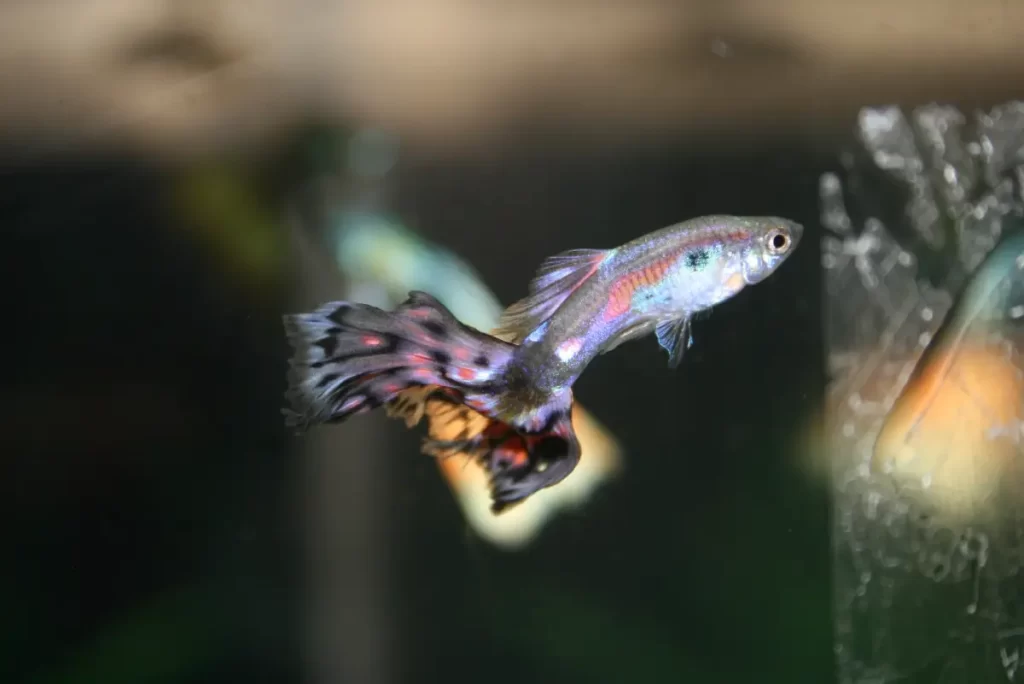
Guppies are vibrant and lively, adding a burst of color to your pond. Similar in size to mollies, these small fish are known for their hardy nature and adaptability. Their peaceful temperament makes them excellent companions, and their preferences align well with mollies in terms of water temperature and conditions.
2. Platies
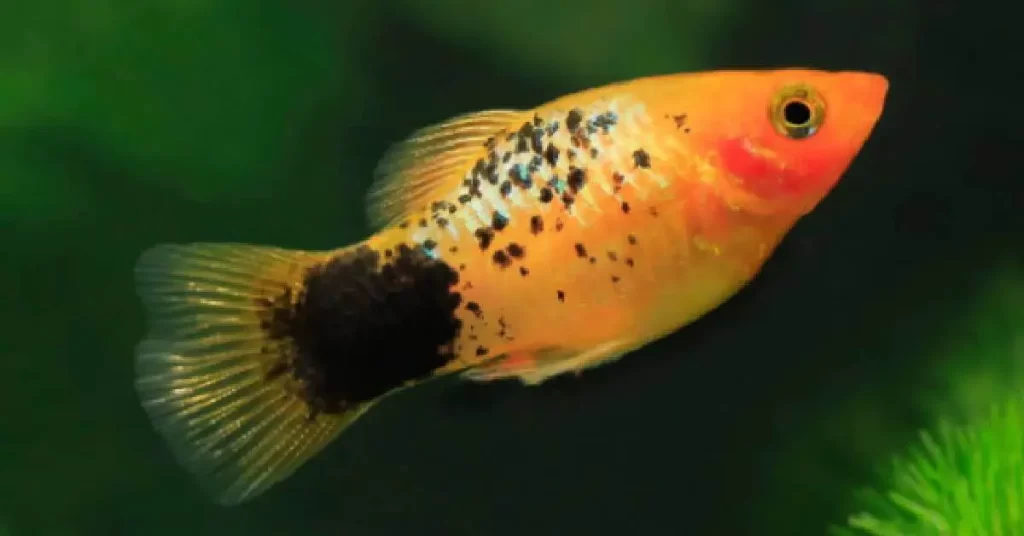
With their playful personalities, platies make delightful pond companions. These small-sized fish come in a variety of colors, enhancing the visual appeal of your pond. Platies share similar preferences with mollies, ensuring a compatible living environment.
3. Corydoras

Corydoras bring diversity to your pond’s ecosystem by thriving at the bottom. Known for their distinctive appearance and peaceful demeanor, these fish complement mollies effectively. Their hardy nature and adaptability make them an ideal choice for a shared pond habitat.
4. Endlers
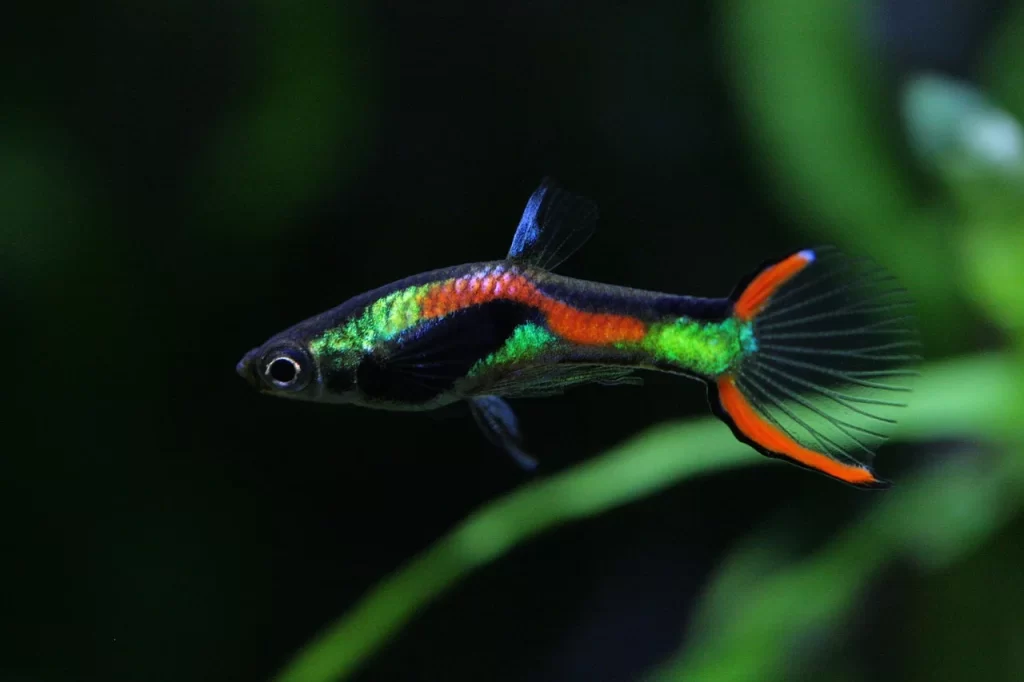
Endlers are not only visually stunning but also energetic pond mates for mollies. Their small size, striking patterns, and easy-going nature make them a perfect fit. These fish enhance the dynamics of your pond, creating a visually appealing and balanced aquatic community.
5. Dwarf Gourami
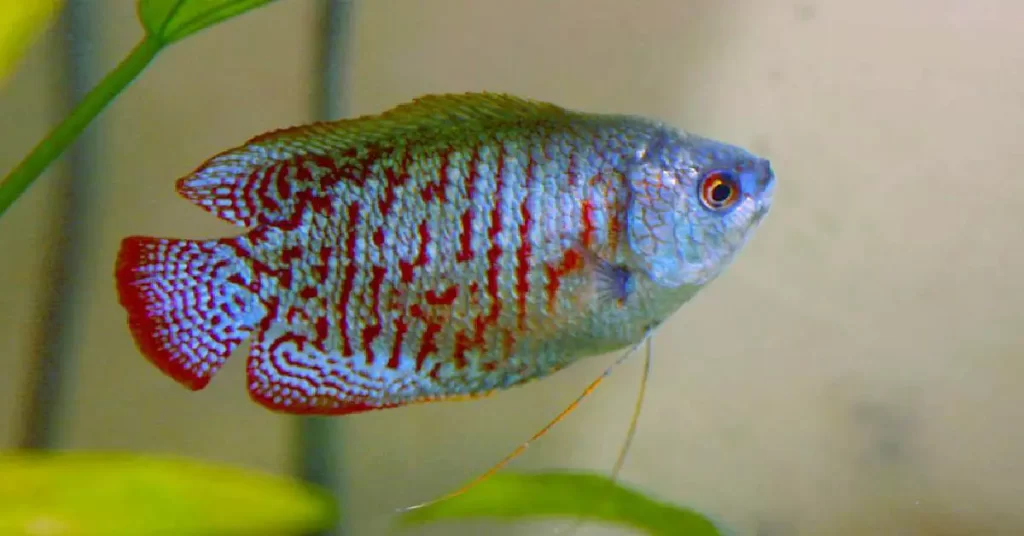
Dwarf gouramis add an elegant touch to your pond. Their graceful movements and vibrant colors make them stand out. These peaceful fish share a compatible temperament with mollies, creating a peaceful atmosphere in your pond.
6. Zebra Danio
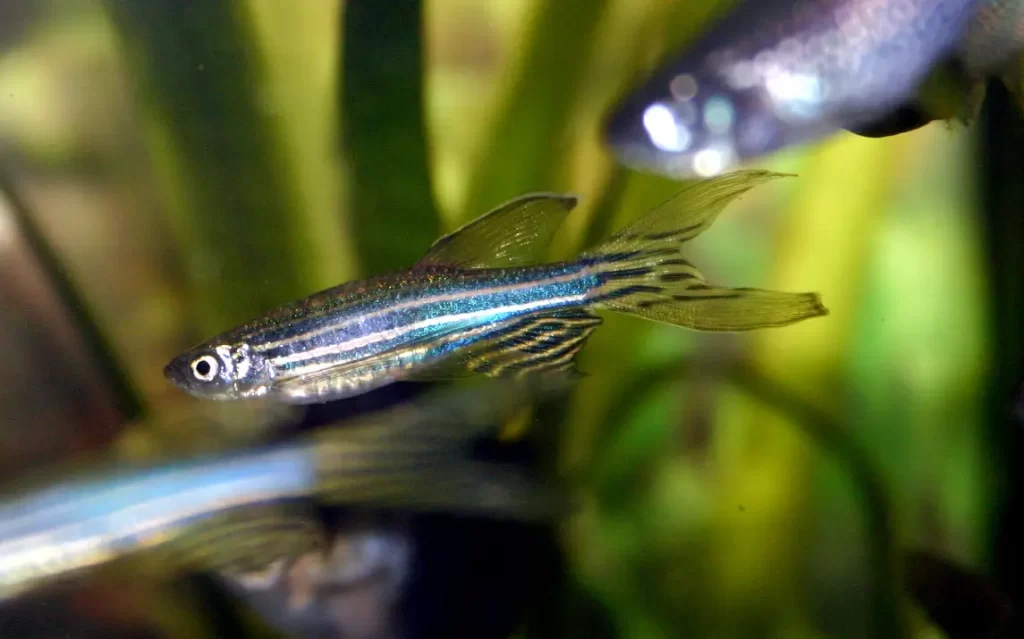
Zebra danios bring lively energy to your pond with their active swimming behavior. Their hardiness and adaptability align well with mollies, ensuring a thriving and balanced pond community. The contrasting stripes of zebra danios also contribute to the visual charm of your aquatic space.
Alternative Fish For Your Outdoor Pond
Looking to add a variety of fish to your outdoor pond without the bustling breeding behavior of mollies? We’ve got you covered! While mollies are wonderful pond inhabitants, some aquarists prefer alternatives due to factors like size or breeding habits. If you’re aiming for a pond with a diverse and balanced community, consider these alternative fish that bring their unique charm to the aquatic landscape.
1. Swordtails
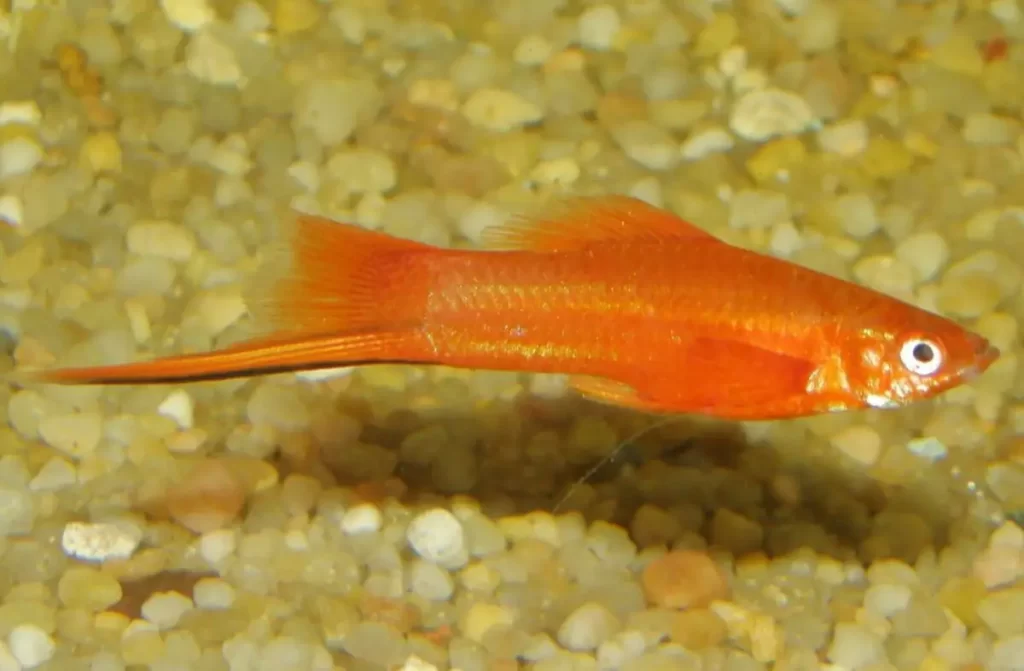
Swordtails are a splendid choice for your pond, bringing elegance and grace to the water. Their distinctive sword-like tail fin adds a touch of sophistication, and they’re not as prolific breeders as mollies. This makes them an excellent alternative if you want to maintain a controlled population in your pond.
2. Rosy Barbs
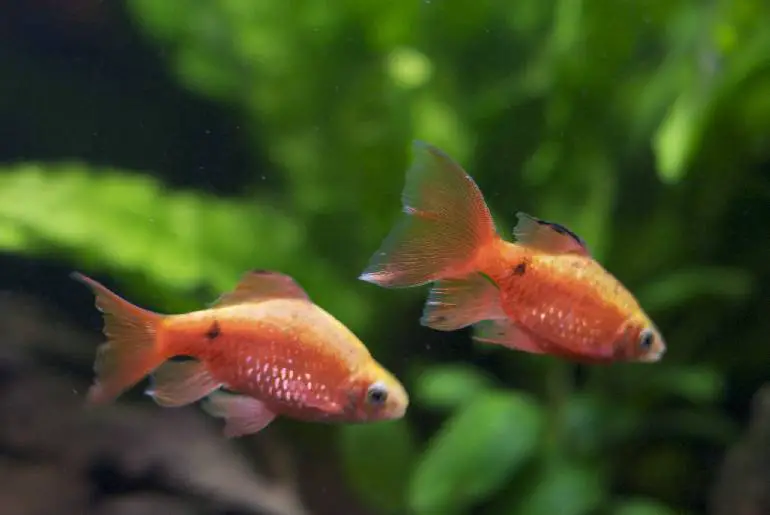
Add a burst of color to your pond with rosy barbs. These vibrant fish are known for their lively nature and striking hues. They thrive in social groups, creating an active and engaging pond environment. With a moderate breeding rate, rosy barbs offer a delightful balance for your aquatic space.
3. White Cloud Mountain Minnows
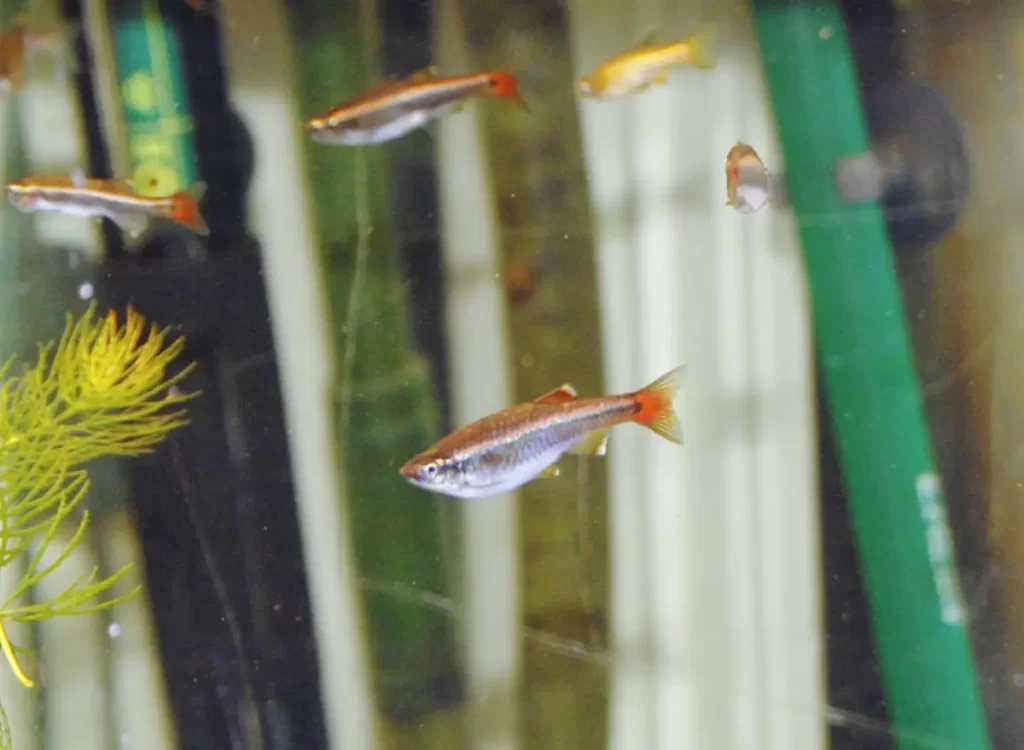
For a serene and delicate touch, consider white cloud mountain minnows. These small, peaceful fish feature a shimmering silver and gold coloration, creating a visually pleasing atmosphere. Their gentle breeding habits make them a suitable choice for pond owners looking for a more controlled reproduction rate.
4. Golden Orfe
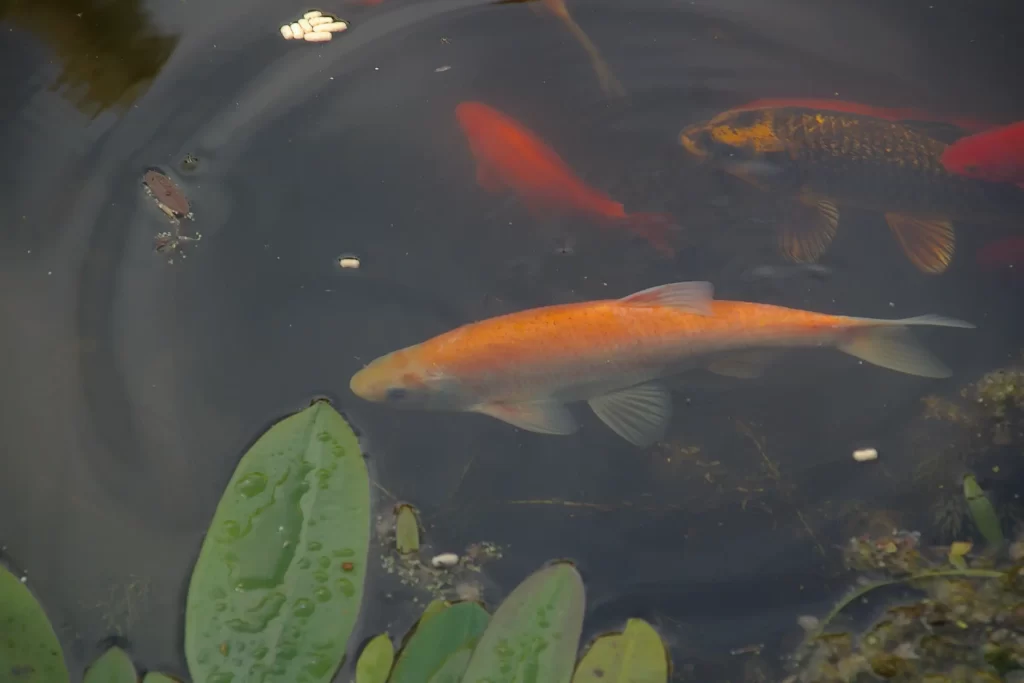
If you’re aiming for larger, majestic fish in your pond, golden orfe fits the bill. With their streamlined bodies and golden scales, these fish add a touch of grandeur to your aquatic setting. While they can breed in suitable conditions, their reproduction rate is generally more manageable than that of mollies.
5. Weather Loach
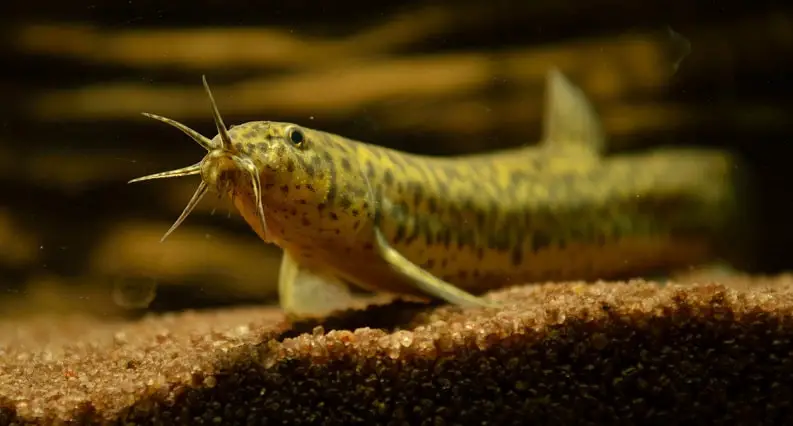
Introduce a quirky element to your pond with weather loaches. These unusual fish have a playful and distinctive appearance, making them stand out. With their moderate breeding habits and fascinating behavior, weather loaches contribute to the charm and diversity of your pond community.
Article Summary: Key Considerations for Keeping Mollies in Ponds
- Gradually acclimate mollies when first introducing them to prevent temperature shock.
- Maintain sufficiently warm water year-round through heaters, chillers and pond placement.
- Test and adjust water parameters like pH frequently to match indoor molly conditions.
- Perform partial water changes routinely to combat waste buildup and stabilize chemistry.
- Add floating plants for shade, shelter, and stabilization of water conditions.
- Use nets and barriers to protect mollies from predators like birds and raccoons.
- Install UV sterilization to control pathogens and parasites in outdoor water.
- Have an indoor habitat ready to relocate mollies once colder weather settles in.
Conclusion
In conclusion, embarking on the journey of pond keeping is not just a hobby; it’s an invitation to savor the simple joys of nature in your own backyard. The allure of vibrant fish, the gentle sway of aquatic plants, and the rhythmic flow of water create a symphony of natural aesthetics that can rejuvenate both the mind and spirit. Whether you’re a seasoned enthusiast or a novice pondering the idea, the world of ponds offers a delightful escape.
Dive into the refreshing experience of cultivating an outdoor pond, and witness the mesmerizing dance of fish and aquatic life. It’s a journey that promises not just a beautiful pond but a serene sanctuary right at your doorstep. So, seize the opportunity to connect with nature, and let the soothing ambiance of a pond become a cherished part of your everyday life. Happy pond keeping!

